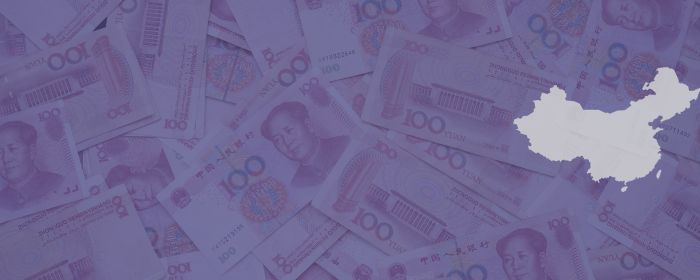The Takeaway
China’s bid to promote its home currency globally is making significant progress, most notably through the country’s first-ever yuan-settled liquefied natural gas (LNG) deal, signed with a French energy giant in March. While some see the deal as a milestone of “de-dollarization,” China has its own internal challenges with the yuan and must climb several more spots to reach the top of the global currency ladder.
In Brief
China National Offshore Oil Corporation, one of China's largest national oil and gas companies, completed the country’s first yuan-settled, cross-border LNG deal with French multi-energy company TotalEnergies on March 28. The deal was settled through the Shanghai Petroleum and Natural Gas Exchange, a state-backed energy trading platform. Although the value of the deal was not disclosed, it involves approximately 58,967 tonnes of LNG originating from the United Arab Emirates to be exported to China.
This deal is widely viewed as a significant step towards internationalizing the yuan, especially in settling oil and gas trades. Earlier in March, Chinese President Xi Jinping’s first post-pandemic trip to Russia saw similar topics brought out in a bilateral natural gas deal. The two countries reportedly inked a deal on March 21 to prioritize the construction of Power of Siberia-2 — a pipeline that could carry 50 billion cubic metres of natural gas from Russia to China every year. This would be equivalent to nearly a third of Canada’s annual natural gas production. Russian President Vladimir Putin confirmed during his meeting with Xi that “[Russia] supports using the yuan in settling trades with Asian, African, and Latin American countries.” Meanwhile, media reports surfaced regarding ongoing negotiations between Saudi Arabia and China for Saudi Arabia to buy Chinese petroleum exports with renminbi.
Implications
China’s push for settling trade and investment in yuan — also known as the “internationalization of the renminbi” — began around the 2007-08 global financial crisis, when Beijing came to believe that using the U.S. dollar as China’s main intermediary could render the country’s financial position more susceptible to international market fluctuations. Realizing the consequences of recent U.S. decoupling, China stepped up its efforts to strengthen its own currency and has scored several wins of late.
In December 2021, the Chinese yuan accounted for 2.7 per cent of global payments — surpassing the Japanese yen and notching fourth place overall — and surged to account for 3.2 per cent of payments in January 2022. China also reached a deal with Brazil on March 30 to trade directly in yuan and reais, with a South American yuan-clearing bank given, for the first time, access to the Cross-Border Interbank Payment System, China’s equivalent to SWIFT.
Moscow, beset by U.S. sanctions, has also boosted the popularity of the yuan. For at least a year, Russia has settled the majority of China-Russia bilateral trade in either yuan or ruble, making the yuan the most traded currency in Russia, replacing the U.S. dollar. Russian energy giant Gazprom PJSC also signed an agreement in September 2022 for China National Petroleum Corporation, the country's largest oil and gas corporation, to pay for gas supplies in yuan and rubles.
Despite reaching milestones in its internationalization, the renminbi’s global use is still dwarfed by the U.S. dollar. Although declining in use in recent years, the U.S. dollar is still the most-used international payment currency at around 40 per cent; it is also involved in over 80 per cent of all global foreign exchange transactions. One of the long-standing concerns international investors have about using the yuan is China’s strict foreign exchange controls, which limit capital flows. While Beijing vowed several times to proceed with capital market reform and has made some pivotal moves to lure international investors, stability and risk prevention — which sometimes get in the way of liberalization — will remain top priorities for China’s financial regulators for the time being.
What's Next
- Fewer greenbacks, more redbacks for oil and gas trades
In 2022, China imported over 454 million tonnes of crude oil and 90 million tonnes of gas, of which approximately 58 million tonnes were LNG. It is expected that as energy demand rebounds and net-zero timelines narrow, other major energy trading partners, including Russia and Middle Eastern countries, would embrace similar arrangements with China and settle more deals with the yuan.
- Yuan’s bumpy overseas expansion as U.S. dollar alternative
One major venue for renminbi offshore transactions is investment through China’s Belt and Road Initiative, for which the currency has made significant inroads in Southeast Asia, Middle Asia, and the Middle East. China argues that many emerging economies in these regions face mounting U.S. dollar debt, potentially making the yuan more attractive. But as some of these economies have strong trade ties with the European Union, doubts remain on whether the yuan would be their preferred alternative when not trading with China.
- Hong Kong spearheading yuan push
Hong Kong plays a key role in China’s go-global currency push as a reigned-in offshore market, especially in issuing yuan-denominated ‘dim sum bonds.’ As the special administrative region struggles to regain its reputation as a free and open global financial hub, both Beijing and Hong Kong hope this financial instrument could gain more traction among foreign investors and ultimately boost Hong Kong’s standing.
• Produced by CAST's Greater China team: Maya Liu (Program Manager); Liam Lau (Analyst); and Dustin Lo (Analyst).




